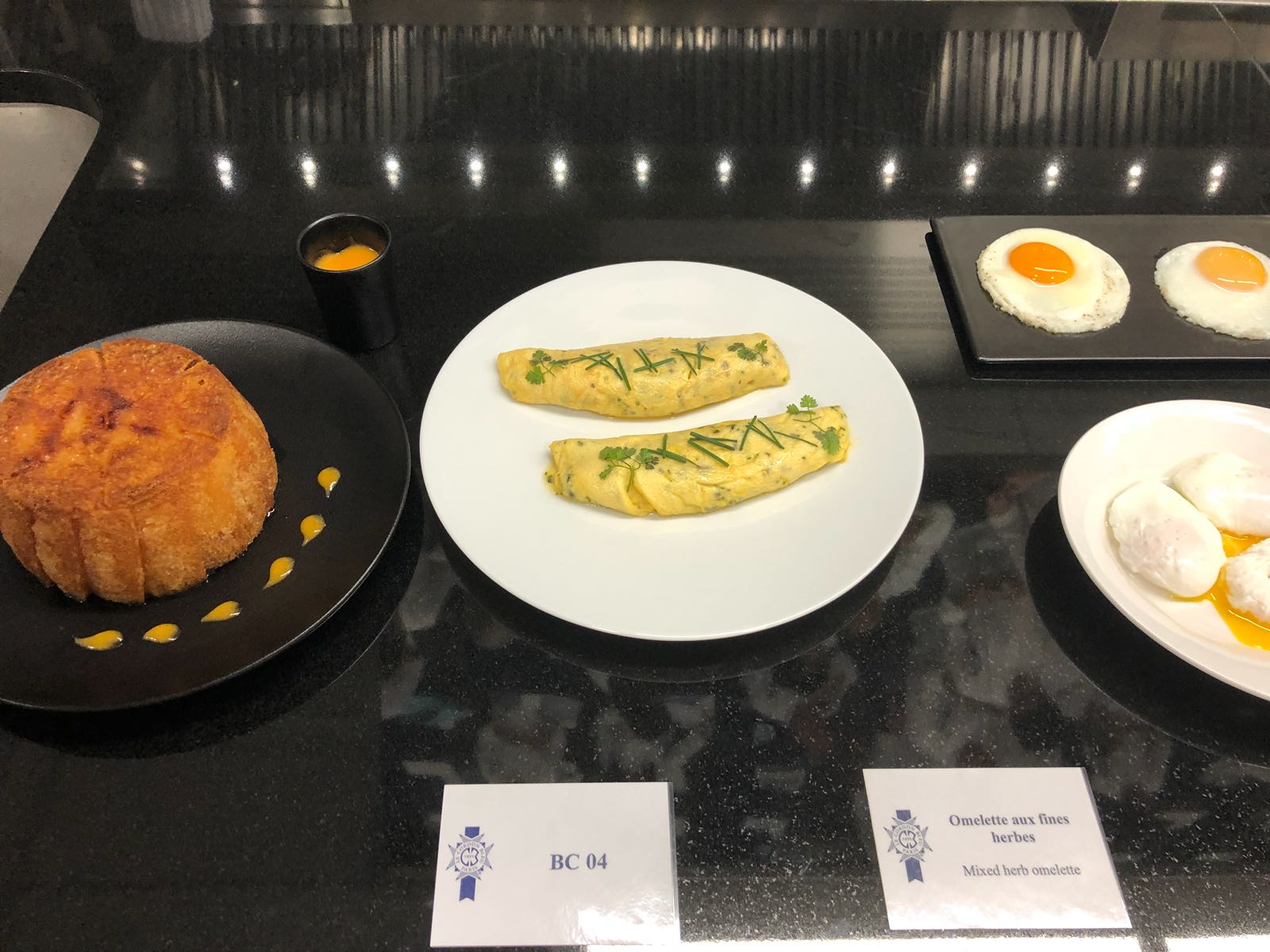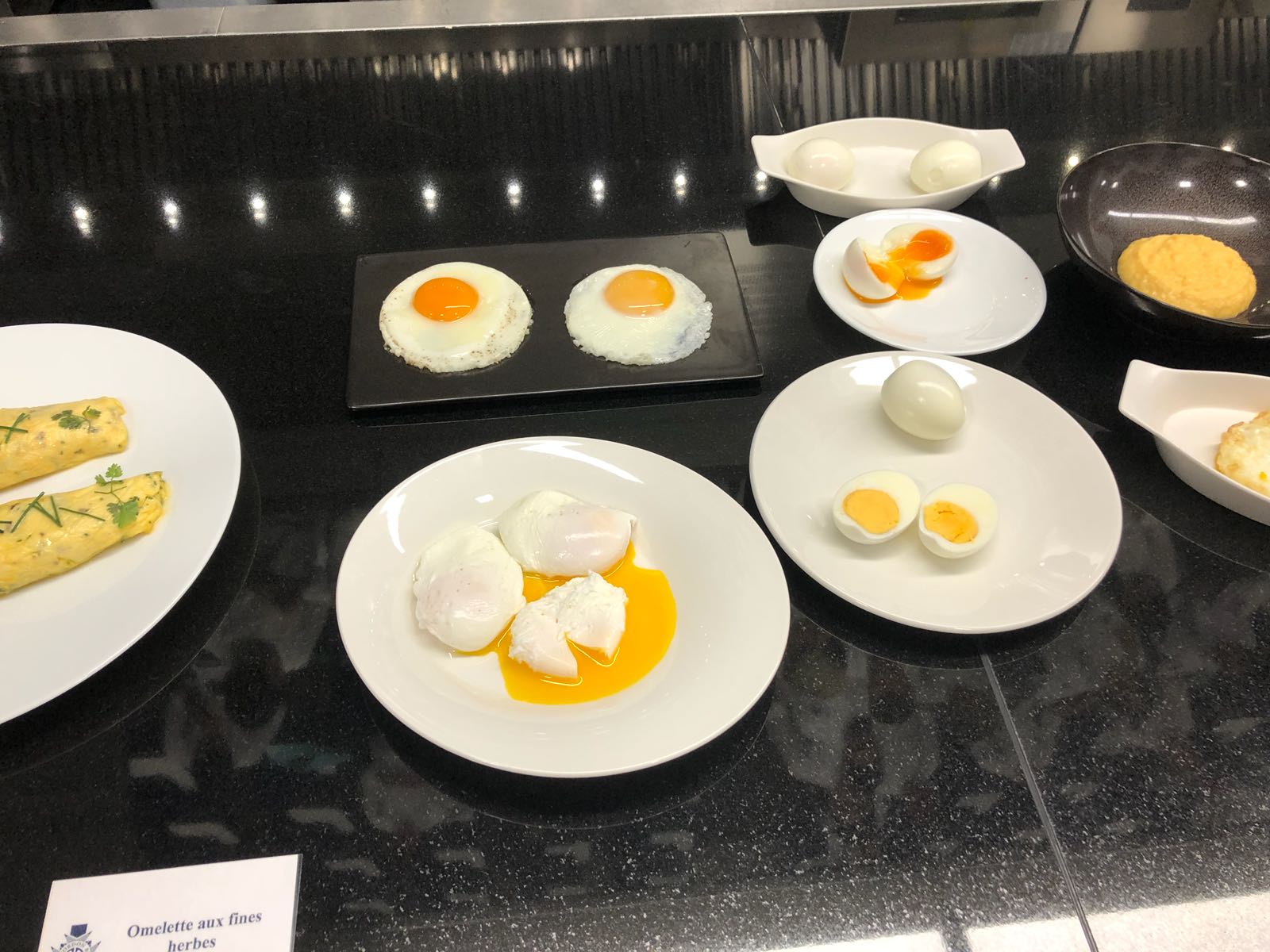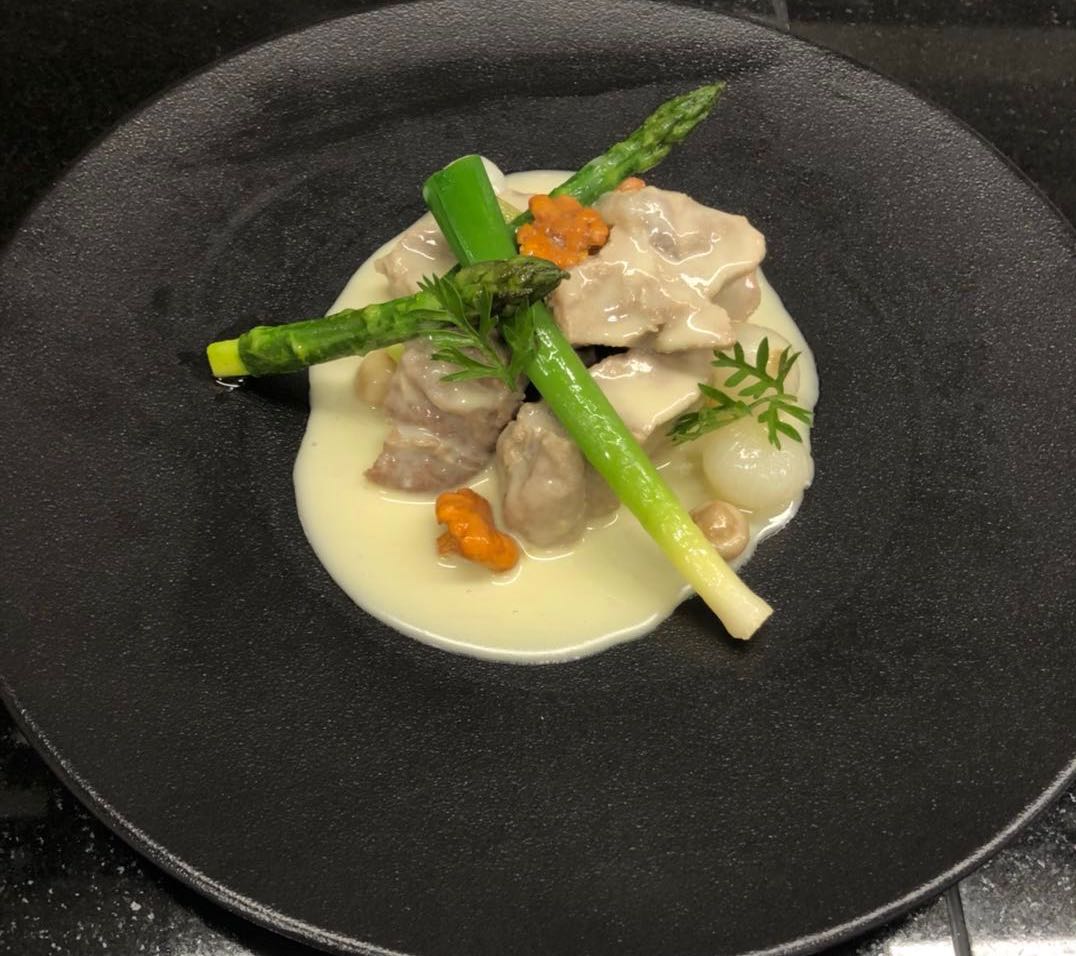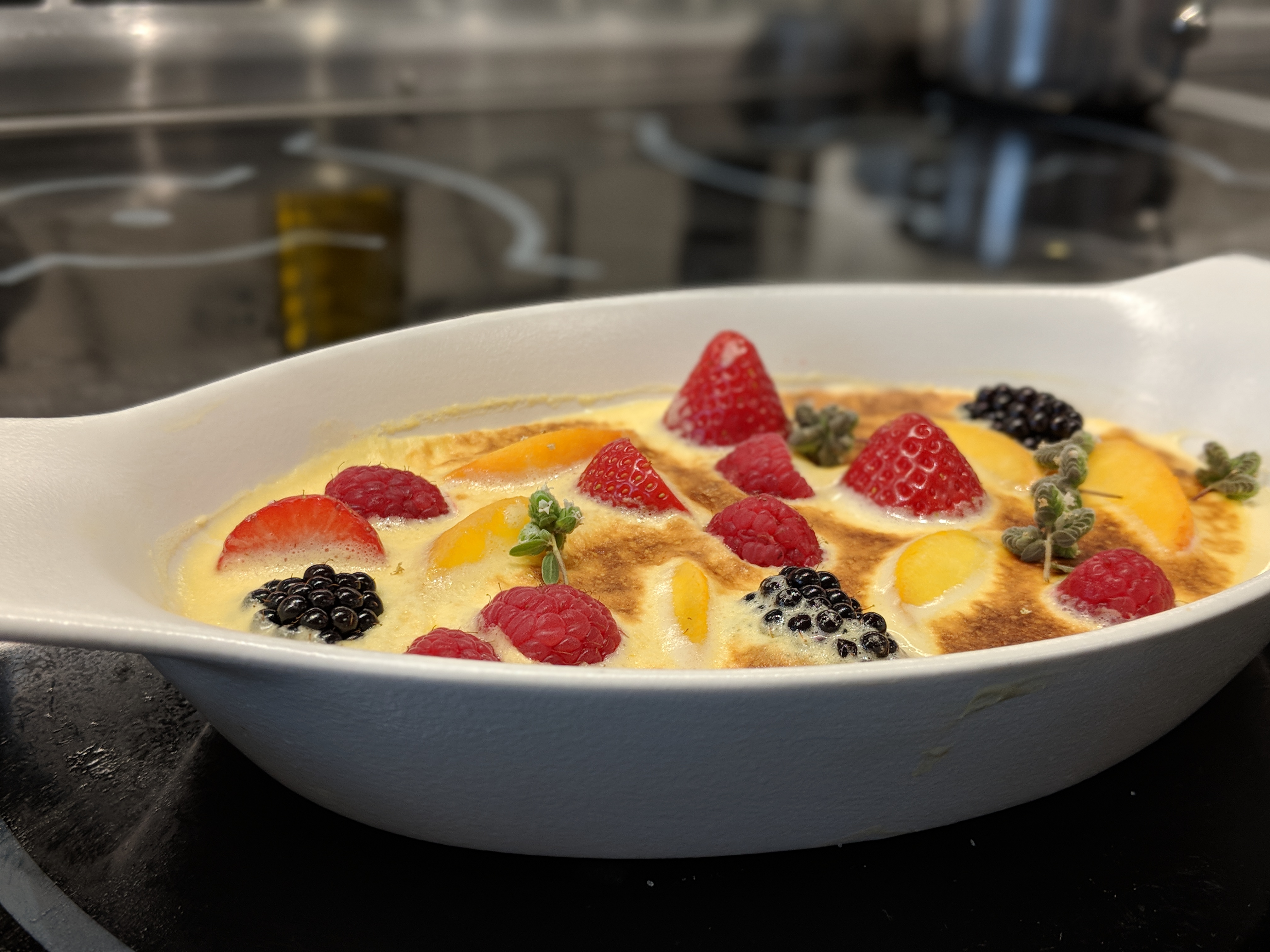Eggs
Jul 6 2018“Pretending is failing. The truth is in the flavor.” - Chef Vaca
The best way to test a chef’s mettle, as common wisdom goes here in France, is by having them prepare an omelette.
The classic French omelette is hardly recognizable next to the fluffy, cakey, slightly-browned, once-folded, stuffed-to-the-brim versions we get at diners and restaurants in the US.
The French omellete is delicate: a paper-thin layer of egg, rolled into a neat oblong, coddling a center of creamy, runny, half-cooked scrambled eggs. The French call this creamy egg texture “baveuse”, from the French word for to “drool” or “slobber.” The surface is perfectly smooth and light-gold. And in traditional French cooking, it is rarely stuffed - the eggs stand on their own, perhaps with a few fresh herbs and some salt and white pepper.

Achieving this perfect color and texture requires serious talent and experience - hence using an omelette as a litmus test for ability in a kitchen.
Eggs must be carefully cracked and scrambled - a good chef never wastes, and so pulls every last drop of egg out of each shell and the bowl. Whites and yolks must be whisked until all trace of white disappears, but no longer. The eggs are salted, then poured into a pan over high heat, and continuously mixed in a two-handed motion - the left-hand swirling the pan and controlling heat, the right whisking the egg mixture in circles with the back of a fork. Some chefs can achieve this using just the motion of the pan itself.
The eggs are swirled and cooked just until they set on the bottom, then rolled from one edge to the other - hammering the handle of the pan with a closed fist to lift the omelette up the lip of the pan to form the ideal shape. The omelette is flipped directly from pan to plate as the outside is set but the center remains “baveuse.”
We had multiple practical sessions here at Le Cordon Bleu where we practiced making the classic French omelette. The challenge was immediately obvious.
Eggs are extremely sensitive. Slightly too much heat, and the eggs will start to brown. An uneven swirl and the eggs will wrinkle. Cooking too slowly, and not paying attention to the pan, and you’ll end up with a thin crunchy crust around the edge. Imperfect whisking and you’ll have flecks of white in your final product. We make dozens of omelettes, and can’t achieve that perfect texture. The chef shakes his pan, seemingly at random, and a perfect omelette comes out in 20 seconds.
One student, struggling with the technique, asks the chef for tips to get better. The chef says “go to the store, buy two chickens, and practice.”
The humble egg is one of the most common ingredients in just about every cuisine around the globe, and holds a very special place right next to butter in the world of French cooking.
We’re all familiar with the egg’s constituent parts: the shell, the white, the yolk. But the properties of these parts of the egg - and the interplay between them - make it a remarkably flexible and dynamic ingredient.
Cooking an egg - as cooking all things - ultimately comes down to performing chemistry.
The egg contains various types of proteins, which, when exposed to heat, will unravel and “denature,” causing them to transform in texture and “set.” Proteins in the egg white will start to thicken at 61°C and set at around 65°C, whereas the yolk will begin to thicken at 65°C and fully set around 70°C.
Because of this difference, we’re able to create a broad range of different cooking styles for eggs, with very precise techniques to create the “perfect” version (at least from a classical French perspective) of each style of egg:
Hardboiled Eggs
Perfectly hard-boiled eggs are boiled 10-12 minutes, depending on size. The egg should always be at room temperature when added to the water - a cold egg added to boiling water is more likely to crack.
When time is up, the egg should be dropped in a bath of icewater, to immediately stop the cooking. Overcooked hard-boiled eggs will develop a slightly greenish tint around the yolk and an off-putting, sulfurous smell - the result of sulfur in the white reacting with iron in the yolk.
Hard-boiled eggs are most easily shelled under running water - the water enters between the shell and the white, releasing the shell.
Poached Eggs
The key to a perfect poached egg is a perfect setup.
Crucially, the egg should be fresh, less than 7 days old - as an egg ages the white tends to separate more from the yolk. The pot should be deep, and very lightly simmering - hot enough to cook the egg, but not a violent boil that will threaten to tear it apart. And the water should include a healthy amount of vinegar - Le Cordon Bleu recommends 1 part vinegar for every 5 parts water.
Create a vortex in the pot by swirling the water in a circle with a spoon, and drop the egg directly in the center - the swirling water will help wrap the white around the yolk, rather than spreading it out.
The egg should be poached two-and-a-half to three minutes - until the whites are set but the yolks are still runny. It is then similarly plunged in icewater, to stop the cooking.
And finally, an attentive chef will always ébarber their poached egg - trimming off loose strands of white to end up with a perfect, smooth result.
Eggs en cocotte
Oeufs en cocotte are eggs baked in a ramekin, with a runny yolk in the exact center of a soft white.
Preheat the oven to 150°C (300°F). Butter the inside of a ramekin, and season the base with salt and pepper. Place the ramekin in a pot of simmering water, such that the water comes part of the way up the sides, but not over the top. Add the egg, and heat in the water while keeping the yolk in the center, until the whites slightly start to set and will hold the yolk in place. Transfer to the oven for 4-6 mins, until the whites are set and the yolk is still runny.
Oeufs en cocotte make for a simple breakfast, and a wonderful base for variation. Add some heated crème fraiche and chopped herbs. Serve with toasted bread for dipping.
Sunny-side up eggs
The key to perfectly sunny-side up eggs: a ring mold.
Place a metal, circular ring mold in the center of a non-stick pan. Season the pan at the bottom of the mold with salt and pepper, so that flecks of seasoning don’t ruin the perfect surface of your egg.
Crack the egg in the center of the ring mold, and cook slowly on low heat - there shouldn’t be any bubbles in the white.
And if you prefer, finish by placing the pan briefly under a broiler to create an oeuf mirroir - a slightly shiny finish on the top of the yolk.
Scrambled eggs - French-style
French-style scrambled eggs are also nothing like their American counterparts.
Where the scrambled eggs you get in the US will have large, fluffy curds, French scrambled eggs will have tiny grains of curd - leading to a creamy, almost polenta-like texture.
Traditionally, French scrambled eggs are done in a baine-marie - a bowl placed over a pan of simmering water - to keep the heat perfectly low and the cooking slow. They can also be done in a stockpot - never a frying pan.
The bottom of the pot or bowl should be lined with butter. Whisk the eggs, and add to the pot once the butter is melted. Stir constantly with a whisk over slow heat, bringing any egg curds that coagulate on the bottom of the pot up to create a perfectly even texture. Finish with more butter, because of course.
The result should be a very fine-grained, creamy scramble - slightly flowing. Use a ring mold to plate, to achieve a perfect circle.
The “Perfect” 63-Degree Egg
The “Perfect” 63-Degree Egg is a more modern invention of the molecular gastronomy era. Cooked in its shell for one hour in a water bath, which is precisely held at 63°C using a sous vide machine, the egg comes out as a perfectly soft-poached, uniform mass - thanks to 63° being right at the temperature where the whites will set but the yolks will remain just on the edge of thickening.

Eggs are also crucial ingredients.
A combination of egg yolks whisked with a bit of cream is called a “liason.” This can be added to finish light stock-based sauces, creating a rich, velvety texture and mouthfeel. The key to a thick, creamy velouté is a liason finish.

Brush egg yolk over a pastry crust or bread before baking - an “egg wash” - and end up with a beautiful shiny coating.

Combine egg yolks with a bit of vinegar and mustard, and whisk in a neutral oil, and you have mayonnaise.
Whisk egg yolks with a bit of water over low heat, and you have a “sabayon.” The sabayon forms the basis for numerous classic French sauces, pastries, and desserts. The basic sabayon calls for about a tablespoon of water per yolk, whisked together over a bain-marie until it is thick, foamy, and runs in “ribbons” from a whisk.
Whisk in melted butter and some lemon juice to your sabayon, and you have a hollandaise. Include a reduction of wine, vinegar, shallots, peppercorns, tarragon, and chervil, and you have a béarnaise. Whisk with sugar and add vanilla and cream, and you have the base for a crème brulée.

Beat egg whites to create the base for a meringue, or soufflé.

Eggs thicken sauces. They bind ingredients together in stuffings and cakes. They leaven breads. So much of our culinary diversity would not be possible without the hidden, complex chemistry of the egg.
Often the simplest objects belie the deepest complexities; true subtelty, and broad possibility, can only reside in the mundane.
Food, like all things, can be taken to flashy, elaborate, indulgent extremes. Real, durable, enviable cooking skill though is being able to take a simple ingredient, deeply understand its properties, hone the right techniques, and ultimately coax out perfection with the swirl of a pan.